Listen to this article:
Key Takeaway
Partner yoga fosters deeper connections and trust while enhancing your individual practice, offering both mental and physical benefits through fun and challenging 2 person yoga poses.
Yoga isn’t only for solitude and meditation. In fact, partner yoga or 2 people yoga can be an amazingly fun bonding experience for friends, significant others, or even strangers in the park to delve deeper into their practice.
Partner yoga improves trust, communication, and connection. Not to mention, it gives you a great stretch and helps strengthen your asana practice.
If it sounds scary or awkward at first, don’t worry! Yoga poses for two people can be surprisingly simple.
Grab your mat, someone you trust, and be ready for plenty of laughter and release.
Here we’ll cover:
- Mental and Physical Benefits of Partner Yoga
- Partner Yoga vs. Acro Yoga
- 15 Easy Yoga Poses for Two People!
Update: We’ve published an article on the best 3-person yoga poses, and 4 people poses if you’re interested.
Contents
Benefits of 2 Person Yoga Poses
Let Go
Yoga poses for two are all about letting go. Of course, we find deep release and inward reflection on the mat alone, but partner yoga takes this to the next level by helping us let go of our ego in a social setting.
Be Vulnerable
On a deeper level, many people in this modern world (including myself) have an underlying fear of intimacy.
It is hard to be vulnerable and share hidden parts of ourselves when everyone else seems like they have their lives perfectly together on social media.
Forge Connections
Practicing yoga poses for two people is transformative because it facilitates connection while relaxing and strengthening our bodies.
We build accountability for our exercise routines while simultaneously opening ourselves up to the fun and vulnerability (and maybe a little embarrassment) of messing up and learning together.
Two-person yoga helps us improve our relationships, both on and off the mat.
Couples yoga and its more advanced variations, acro yoga, are an opportunity to connect mentally, emotionally, and physically.
Expect plenty of laughter, goofy mess-ups, and hilarious communications!
Other benefits include:
- Build accountability in your yoga practice
- Improved communication skills
- Learning to listen
- Building trust
- Engaging with your intuition
- Feel more connected to your friend or yoga partner
- Get a deeper stretch than you could alone
- Strengthen core, shoulders, legs, and joints
- Laughter medicine!
Partner Yoga Poses vs. Acro Yoga
Partner yoga simply means any yoga poses that are done with two people. It’s a whole different world of yoga that builds on your practice while also creating more community.
There are hundreds of easy yoga poses for beginners to try with a friend, yoga instructor, or significant other. As a couple, I’ve found that yoga with my partner has strengthened our relationship and made us laugh our butts off!
Acro is a unique type of partner yoga that brings practitioners into more acrobatic and “flying” yoga poses. These more advanced yoga poses have one person as the base and the other lifted off the ground.
Whether you want to stay on the ground or try out acro yoga poses, we have 15 different partner yoga poses for two people to try, whether you are a beginner or a seasoned yogi.
Seated Easy Yoga Poses for Two People
Partner Seated Cat-Cow
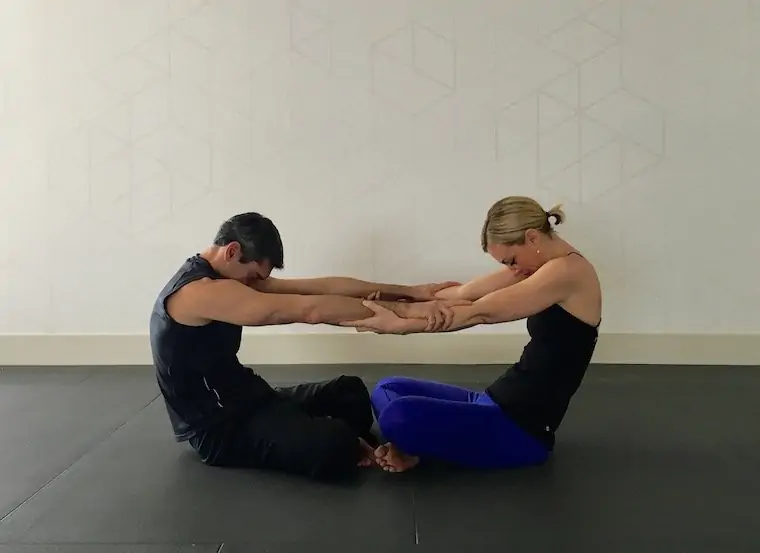
The perfect warm-up for your spine and breath. Try syncing your breath together to prepare for upcoming poses.
- Sit cross-legged opposite of each other, knees touching
- Take hold of each other’s forearms, one partner with hands on top of elbows and the other partner with hands beneath
- Rock back and forth a little to explore your trust when leaning back
- Inhale together and slide your shoulders down the back, arching your spine like a floor cat pose, pushing your chests toward each other
- Exhale and round forward into a C-shape, using your linked forearms to brace against each other and suck your stomachs inward, leaning back until you feel a nice stretch
Seated Forward Fold with Partner
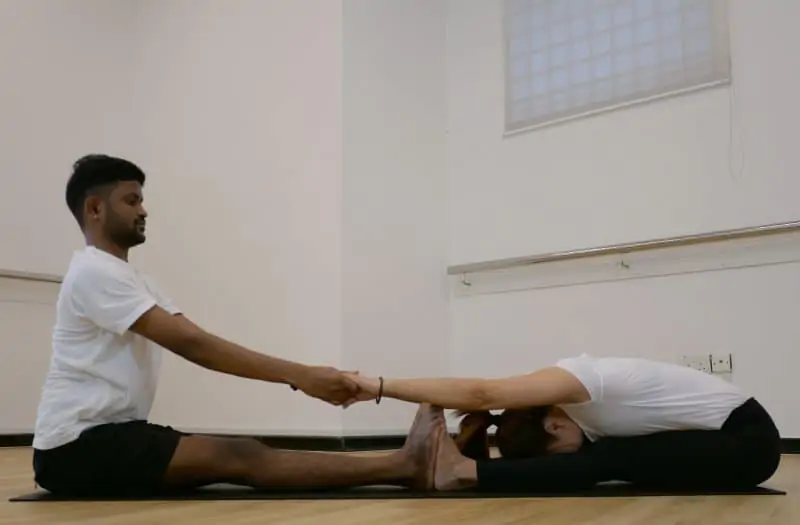
Release and warm up your hamstrings and lower back with this modification of paschimottanasana. Several modifications depend on each partner’s flexibility.
- Sit facing each other with your legs in a straddle (wide V) position, touching your feet
- If you are different heights, adjust the width of your legs to accommodate
- Press the bottoms of your feet against each other
- Take hold of your partner’s wrists or forearms (not their hands) and form a nice comfortable grip
- Very slowly begin rocking back and forth; one partner leans back and the second partner can slowly fold forward
- Once you feel your hamstrings warm up, take turns holding the forward fold and communicate with your partner about how much they should lean back to gently pull you forward
- Swap back and forth to continue slowly opening the stretch for both of you
Back-To-Back Twist
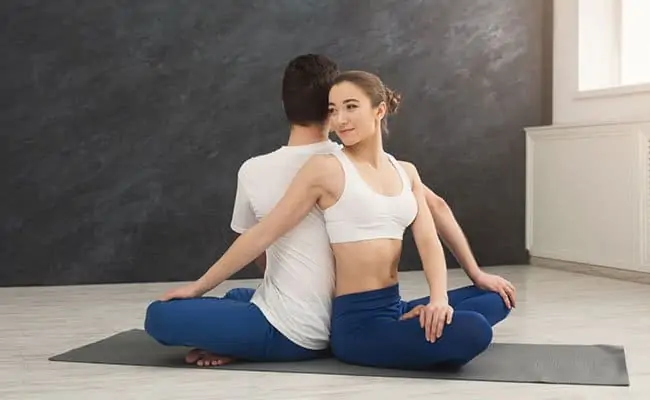
For a final seated warm-up, try out this gentle twist using your partner’s knee to leverage your back deeper.
The great thing about this pose is how easy it is to keep the spine straight because of the support from your partner.
- Sit back-to-back with your legs crossed
- Inhale and feel your spines lengthen together
- On an exhale, twist clockwise and spiral around together
- Both people put their right hand on their right knee
- Then, reach your left hand behind you to grab hold of your partner’s right thigh
- Use slight pressure to brace your backs straight against each other and use the legs to twist deeper
- Hold and then try the other side, communicating about what feels good for both partners
Standing Easy Yoga Poses for Two
Double Tree Yoga Pose

Moving to standing poses, the double tree helps with improved balance and trust between partners. It is important to communicate with each other for even weight distribution in this pose.
- Both partners start standing forward with hips side by side
- Press your palms together in prayer
- Release your inner arm and wrap it around the outside of your partner’s waist
- Keeping the remaining hand in prayer position in the middle, press your palm against your partner’s palm to form a unison prayer (your outer arm will be reaching across your chest to meet in the middle)
- Shift your weight onto the leg closest to your partner
- Lift the outside leg into tree pose, placing the bottom of your foot on the inner shin, thigh, or hip
- Breathe and hold, then trade positions and try the other side
Double Chair Pose
To continue the balancing series, add this little fun quad-activating chair pose to help both partners build strength.
- Start in a standing position, touching back-to-back
- Interlace your hands through each other’s arms, linking elbows together
- Push into each other and begin walking your legs a few steps out in front of you
- Talk with the other person to coordinate squatting down in unison (you may need to bring your feet further out)
- As you move down, try to get thighs parallel to the ground and knees at a right angle
- Feel your quads and glutes activate, pressing your backs against each other and syncing your breath
- Hold for a few breaths, or as long as is comfortable
- Coordinate and communicate to simultaneously straighten your legs and walk your feet back to where you started
Partner Standing Forward Fold

Now that you’ve fired up those legs, try a deeper hamstring opener that will also help release any lower back tension. This one requires a lot of trust and plenty of comfort together, as you are butt-to-butt and very much depending on your partner to make sure you don’t fall.
This pose can also be done with wide legs if you aren’t quite as flexible in a standard forward fold.
- Start in a standing position, facing away from your partner, with your heels about 6″ apart from each other
- Fold forward with a slight bend in the knees, just like a normal standing fold
- Drop your head down toward the floor, feet flat and weight in heels
- Reach your hands toward the back of your legs and use your hands to hold your partner’s shins
- Allow your tailbones to press slightly against each other as you move into a deeper stretch and reach for your partner’s shoulders
- Both partners should have their necks down, reaching toward their shins, releasing the lower back, and bracing their balance against the other partner’s arms and shoulders
- Communicate, take deep breaths, and hold
- Release by slowly bringing your hands in front of you and rolling your spine back up to stand.
Double Temple Pose
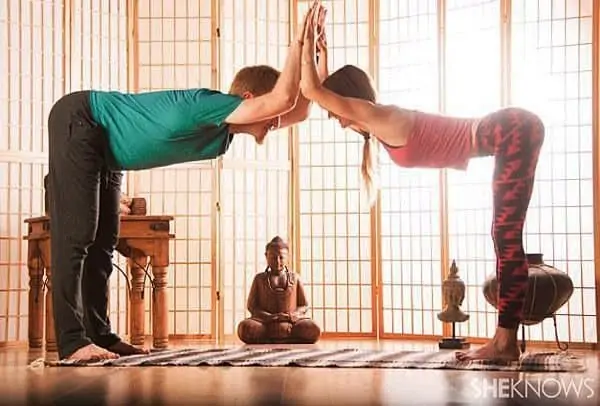
This is one of my favorite yoga poses for two people because it offers a deep shoulder and chest opening while leaning on each other for support.
- Stand facing each other with both partner’s feet hip-width apart
- On an inhale, bring your arms overhead, palms forward
- Keeping your legs straight, hinge forward at the hips and meet your partner’s hands
- Continue folding forward, bringing your elbows, forearms, and hands to press into each other with equal weight
- Let your stomach and chest release toward the ground, arching your back and opening the heart
- Sync your breath together for a few breaths
- To release, slowly walk toward each other until you return to standing
Double Dancer
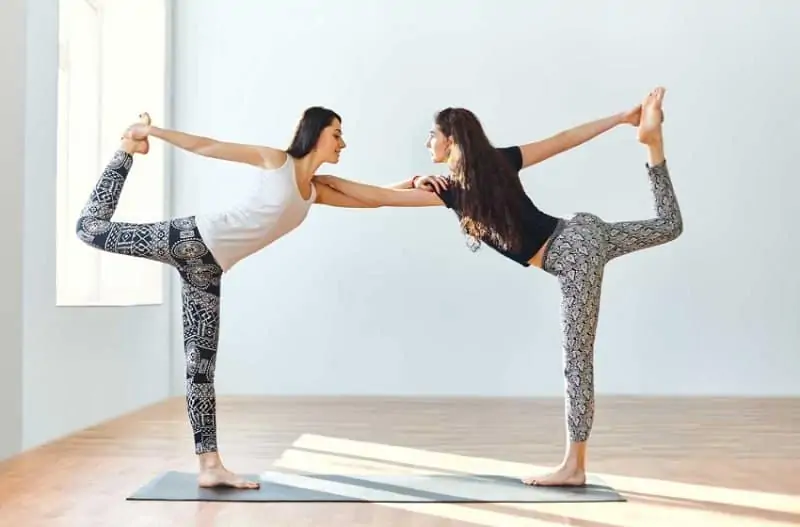
Dancer is another one of those easy yoga poses that gets better with a partner because you can support each other’s balance. A double dancer opens the heart and spine.
- Start by facing your partner on opposite ends of a yoga mat
- Inhale your left arm up toward the sky as your partner does the same and then reach toward each other, grabbing hold of the other person’s shoulder and linking your arms together
- Shift your weight onto the left-standing leg
- As you bend your right knee, grasp the inner arch of your right foot
- Slowly kick your right foot back and up as you lean forward, moving into dancer pose and balancing with your partner to support each other
- Talk and make adjustments as needed, holding for 30 seconds or more and opening the spine into a deeper arch as you kick the back glute further up
- Release by lowering the back leg and unbinding your arms
Intermediate Couples Yoga Poses for Two People
Partner Downward Facing Dog

If you feel enough trust and connection with the other person, try this modified double take on the classic downward-facing dog.
This yoga pose stretches your back and hamstrings. It is easier than it looks but requires plenty of focus and communication.
- Partner 1 starts in a normal downward dog pose
- You begin standing facing the same direction as your partner, feet on opposite sides of their arms
- Hinge into a standing forward fold, placing hands on the floor
- Shift your weight slowly into your hands as you carefully lift your right leg and place one foot on your partner’s back
- Gently lift the other foot to their back and walk your feet toward their hips, gently pushing on their lower back and communicating about how the stretch feels as they deepen their downward dog
- Once in a supported handstand, try to align your hips, shoulders, and hands
- Hold and breathe, checking in with the second partner
- To release, slowly bend one knee and step back to the ground, following with the other back to a forward fold
- Let the base partner ease out of the pose and switch to the top person
Reverse Warrior II with Partner

Lengthen the side body and create some heart-shaped body art with your arms. This reverse warrior is great for grounding and connecting with your yoga partner.
- Begin in Warrior 2 with knees bent away from each other and hips aligned forward
- The side blade of each partner’s back foot is pushing against your partner, grounding and checking that your foot arch is not collapsing inward.
- The backhand is resting on the thigh
- Inhale together and lift the front arm up
- Exhale into a reverse warrior, feeling a deep stretch in your side body as you slide your back hand down your thigh
- Feel you and your partner’s top hands reaching for each other, trying to touch fingertips, interlace the fingers, or reach a combination prayer position
- Exhale out of the Warrior 2 pose and repeat on the other side
Balancing Warrior III Yoga Pose with Partner
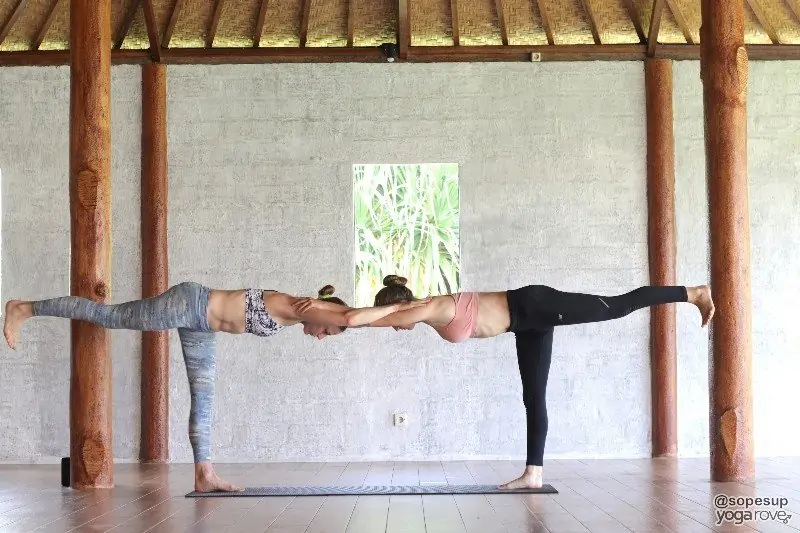
This is one of those yoga poses for two people that is easier than doing it on your own. With the support of a second partner, you can hold the balance longer and go deeper.
The hard part is syncing your movements together when you can’t see each other. Don’t be afraid to talk each other through it!
- Begin facing each other with arms outstretched and fingertips touching (you may have to move closer or farther apart as you enter the pose)
- Lengthen your arms up overhead and face palms toward your partner
- Hinge at the hips, keeping arms straight until you reach a 90° angle between your torso and legs
- Hold your partner’s biceps firmly and adjust your distance as needed
- Both partners shift weight into the right leg and lift their left leg behind them into a Warrior III yoga pose (because you’re facing each other, the diagonally opposite legs build more support)
- Engage your core, release your gaze downward to extend tyourneck, and take deep breaths
- To release, simply step the lifted leg back down and repeat on the other side
Double Plank Pose

Plank is a core challenge on its own, but now you can try adding in a balance with your partner! This pose works best with partners of the same size or the larger partner on the bottom.
Be prepared to laugh if your stack doesn’t quite work out the first time!
- One person begins in a classic plank position, hands flat and core engaged
- Entering from the side, the top person carefully grabs both ankles of the base’s feet
- Then, the top partner places the ball of one foot onto the shoulder of the base, being careful not to dig into their shoulders with their toes
- Engage the core, lift the other foot up, and enter the plank, trying to inhale and exhale at the same time
- Hold the plank for 30 seconds
- Release by having the second partner gently step off the base’s shoulders and stand back up
Airplane Plank

This is one of my favorite yoga poses for two people because it reminds me of being a little kid. This partner pose is great for beginners and advanced yogis alike, offering opportunities to explore other acrobatics if you’d like.
- Begin with the base partner lying flat on the ground, engaging their ab muscles, and lifting their straight legs into the air at a 90° angle
- The flyer stands facing the base’s raised legs
- The base partner places their feet on the hip flexors or groin area of the flyer, adjusting the toes outward into a slightly V shape that is most comfortable for the flyer to put pressure on
- The base extends their arms up and the flyer grabs their hands (the base’s knees will likely need to bend to allow the reach) and both partners lock out their arms
- As the flyer, engage your core and shift your body weight forward into the base’s feet as the base lifts upward
- The base will gradually straighten their legs while keeping their core tightly engaged as the flyer shifts to “flying” plank above them, keeping the pressure evenly distributed between the two partners’ locked arms and foot-hip connection
- Engage the whole body, find balance, and breathe
- Release by slowly bending the knees and shifting the flyer back toward the ground, or stay up and move into the next position.
Folded Leaf
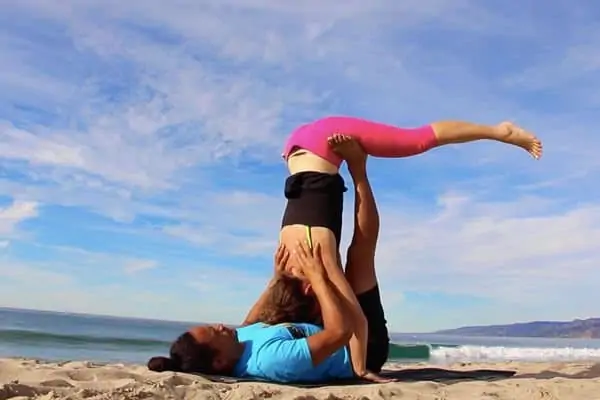
This yoga pose is an easy transition from the Airplane Plank pose. It is one of the most therapeutic two-person yoga poses because the flyer can enjoy such amazing spinal lengthening and release.
- As the flyer begins at the top of the Airplane Plank, soften your arms and find balance, maintaining all the weight of the flyer in the hips
- As the base slowly brings their arms down to the side, let yourself hinge forward into an “L” shape
- Release your neck and back, trusting that your partner’s feet are firmly planted under your hips
- The base can keep the core engaged and gently massage your neck as you dangle
- To release, re-engage your hands and find balance; push back up into Airplane, and then let your base lower you to the ground with knees bent
Supported Backbend Yoga Pose
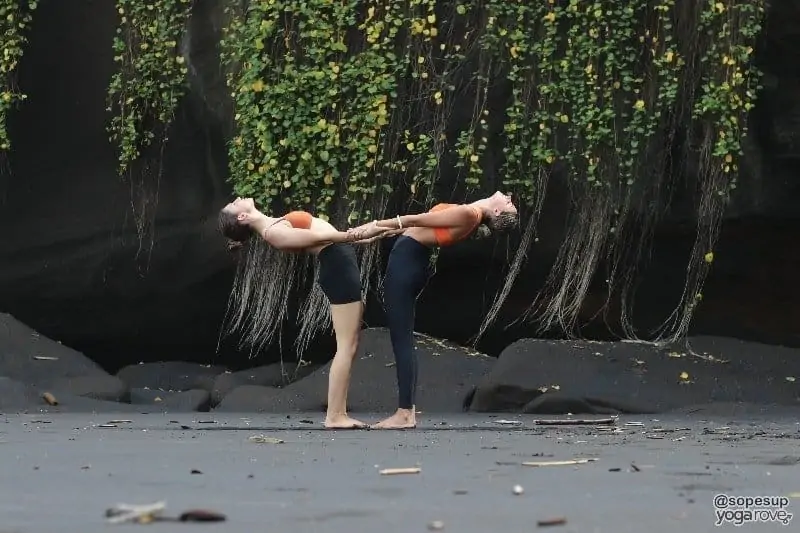
Backbend yoga poses are always a bit tricky, but the supported version allows you to go deeper without hurting your spine.
- Start facing your partner with feet flat and toes touching
- Bring your arms forward and take hold of your partner’s forearms
- Engage the glutes to protect the lower back, inhale to lengthen the spine, and on an exhale, slowly begin arching backward, looking behind you and releasing your neck
- Brace against your partner, slightly pulling against each other’s weight, until you trust to fully release your back against the leverage of their arms
- Hold for a few breaths, then release by engaging the core and butt to return to standing
The Significance of Breathwork in Partner Yoga
Breathing is often an activity in our lives but in the realm of yoga, it holds a significant role. Synchronized breathing fosters a connection between partners beyond coordination. It goes beyond matching rhythms; it’s about sensing each other’s vibes and energies.
My partner and I personally experienced this effect when we delved into this practice together. Beginning with poses and honing in on our breath helped us move as one entity.
During poses harmonizing our breaths proved instrumental in maintaining equilibrium. It served as a form of communication; if one of us faced challenges a shared deep inhale or exhale signaled the need for adjustments.
This aspect not only enhanced our practice but also enriched our bond through mutual trust and comprehension. Furthermore, synchronized breathing affects the mind. When faced with difficulties executing a pose frustration can easily set in.
However, by anchoring ourselves to our breath patterns we found patience and solace during these moments of struggle. This shift allowed us to appreciate the journey itself, rather than solely fixating on achieving outcomes.
When you’re exploring partner yoga remember the significance of incorporating breathwork. It could unlock a bond. Enhance your practice in meaningful ways.
Safety Advice for Partner Yoga
Before Getting Started
Before delving into those poses let’s discuss the importance of safety. Safety is crucial in any yoga session especially when practicing with a partner. First and foremost communication is key. Whether you’re new to yoga or an experienced practitioner talking things out is essential. It helps in understanding each other’s boundaries and comfort levels.
Be Mindful of Your Limits
Additionally, it’s important to be aware of your limitations. Partner yoga isn’t about pushing each other beyond your capabilities; it’s about striking a balance and enjoying the journey together. If something doesn’t feel right don’t hesitate to communicate. There’s no shame in taking a step or trying a pose that works well for both of you.
Never Skip the Warm Up
Remember not to overlook the warmup phase. I understand the excitement to jump into those poses. Trust me on this one – a proper warm-up lays the foundation for a smoother and safer practice session. It prepares your muscles. Minimizes the risk of strains or injuries.
Stay Engaged in the Moment
Lastly, remain present throughout your practice. While it may be tempting to focus on perfecting a pose partner yogas true essence lies in being engaged with each other.
In those times when we truly connect and are fully engaged with each other it’s important to savor the moment. Relax, take a breath, and appreciate the present.
Partner yoga revolves around trust, bonding, and shared enjoyment. Just remember these safety guidelines. You’re ready, for a yoga experience, with your partner.
Friends and Couples Who Yoga Together, Stay Together!
There is evidence that couples (romantic or friendly) who sweat together are more likely to stay together.
The excitement of physical challenges and working toward a goal (like two-person yoga poses, for example) builds trust, communication, and bonding.
Have you tried any of these yoga poses with a friend or significant other? We’d love to know!
Namaste!
Pop quiz! 🧘🤔
Partner yoga can improve trust and communication between participants.
Partner yoga poses are only for advanced yoga practitioners.
Laughter and fun are unexpected benefits of practicing yoga poses for two people.


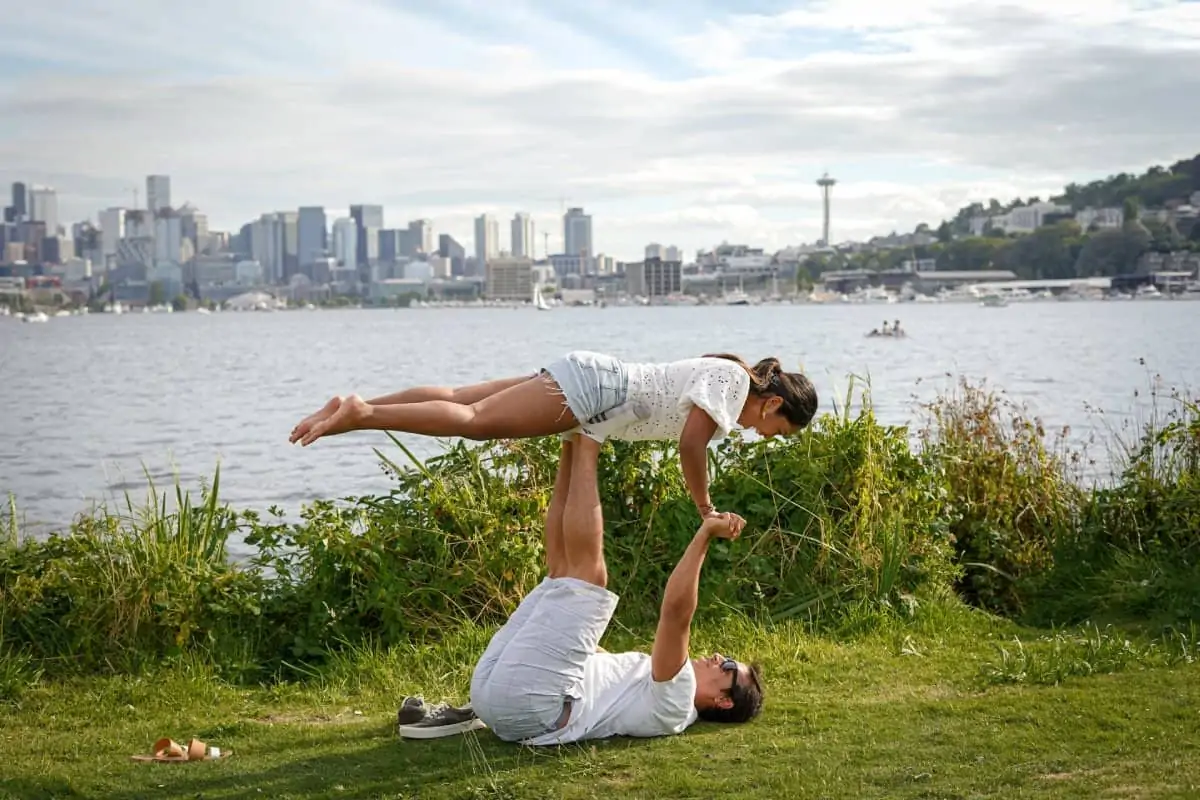






The practice of couple yoga allows you to build trust in a relationship and at the same time improve the physical fitness of both partners.
By practicing yoga daily, the couple breathes new life into their relationship and joins the vast number of people who have already experienced the benefits of the training:
harmonization of relations due to the emergence of new common interests;
development of strength and endurance;
transition to a new level of stability in relations;
improving the elasticity of muscles and ligaments.
You can read the complete article and see all possible poses for 2 persons from here:
https://www.medpgr.com/yoga-poses-for-2-persons/
Here are 20 yoga poses for two people:
Yoga poses, also called asanas, are physical postures that are used in the practice of yoga including yoga poses for two people. There are many different yoga poses, each with a specific set of benefits for the body and mind. Some yoga poses are designed to strengthen and tone the body, while others are meant to improve flexibility and balance. Still, other poses are intended to calm the mind and promote relaxation.
Partner Yoga
Partner Tree Pose
Partner Warrior II
Partner Boat Pose
Partner Bridge Pose
Partner Headstand
Partner Child’s Pose
Partner Camel Pose
Partner Reverse Warrior
Partner Triangle Pose
Partner Pigeon Pose
Partner Downward-Facing Dog
Partner Fish Pose
Partner Lion’s Breath
Partner Forward Fold
Partner Wheel Pose
Partner Crow Pose
Partner Half Lord of the Fishes Pose
Partner Plank Pose
Partner Seated Straddle Forward Fold
Read the Complete article: https://www.medpgr.com/yoga-poses-for-two-people/